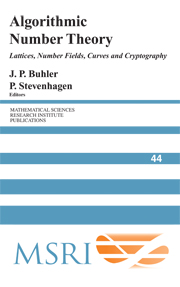Book contents
- Frontmatter
- Contents
- Preface
- Solving the Pell equation
- Basic algorithms in number theory
- Smooth numbers and the quadratic sieve
- The number field sieve
- Four primality testing algorithms
- Lattices
- Elliptic curves
- The arithmetic of number rings
- Smooth numbers: computational number theory and beyond
- Fast multiplication and its applications
- Elementary thoughts on discrete logarithms
- The impact of the number field sieve on the discrete logarithm problem in finite fields
- Reducing lattice bases to find small-height values of univariate polynomials
- Computing Arakelov class groups
- Computational class field theory
- Protecting communications against forgery
- Algorithmic theory of zeta functions over finite fields
- Counting points onvarieties over finite fields of small characteristic
- Congruent number problems and their variants
- An introduction to computing modular forms using modular symbols
Basic algorithms in number theory
Published online by Cambridge University Press: 30 May 2025
- Frontmatter
- Contents
- Preface
- Solving the Pell equation
- Basic algorithms in number theory
- Smooth numbers and the quadratic sieve
- The number field sieve
- Four primality testing algorithms
- Lattices
- Elliptic curves
- The arithmetic of number rings
- Smooth numbers: computational number theory and beyond
- Fast multiplication and its applications
- Elementary thoughts on discrete logarithms
- The impact of the number field sieve on the discrete logarithm problem in finite fields
- Reducing lattice bases to find small-height values of univariate polynomials
- Computing Arakelov class groups
- Computational class field theory
- Protecting communications against forgery
- Algorithmic theory of zeta functions over finite fields
- Counting points onvarieties over finite fields of small characteristic
- Congruent number problems and their variants
- An introduction to computing modular forms using modular symbols
Summary
Our subject combines the ancient charms of number theory with the modern fascination with algorithmic thinking. Newcomers to the field can appreciate this conjunction by studying the many elementary pearls in the subject. The aim here is to describe a few of these gems with the combined goals of providing background for subsequent articles in this volume, and luring the reader into pursuing full-length treatments of the subject, such as [Bach and Shallit 1996; Bressoud and Wagon 2000; Cohen 1993; Crandall and Pomerance 2005; Knuth 1981; von zur Gathen and Gerhard 2003; Shoup 2005].
Many details will be left to the reader, and we will assume that he or she knows (or can look up) basic facts from number theory, algebra, and elementary programming.
We tend to focus more on the mathematics and less on the sometimes fascinating algorithmic details. However, the subject is grounded in, and motivated by, examples; one can learn interesting and surprising things by actually implementing algorithms in number theory. Implementing almost any of the algorithms here in a modern programming language isn’t too hard; we encourage budding number theorists to follow the venerable tradition of their predecessors: write programs and think carefully about the output.
Information
- Type
- Chapter
- Information
- Algorithmic Number TheoryLattices, Number Fields, Curves and Cryptography, pp. 25 - 68Publisher: Cambridge University PressPrint publication year: 2008
